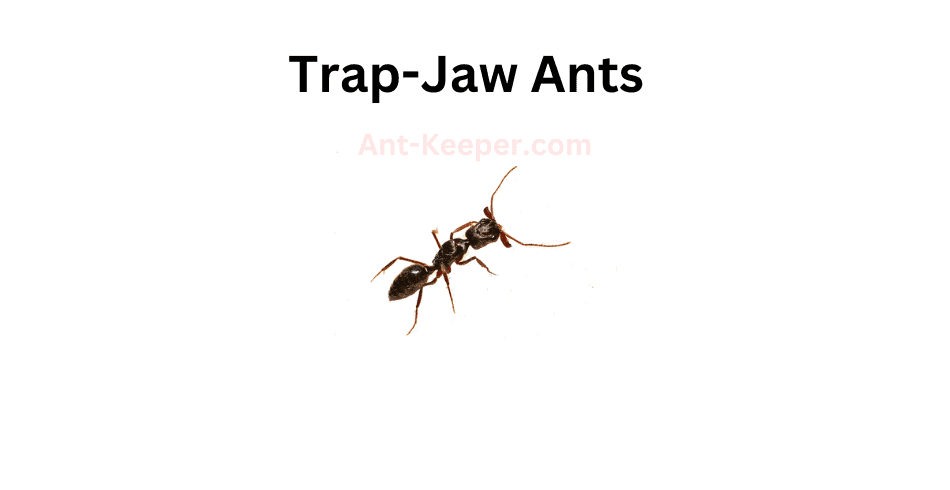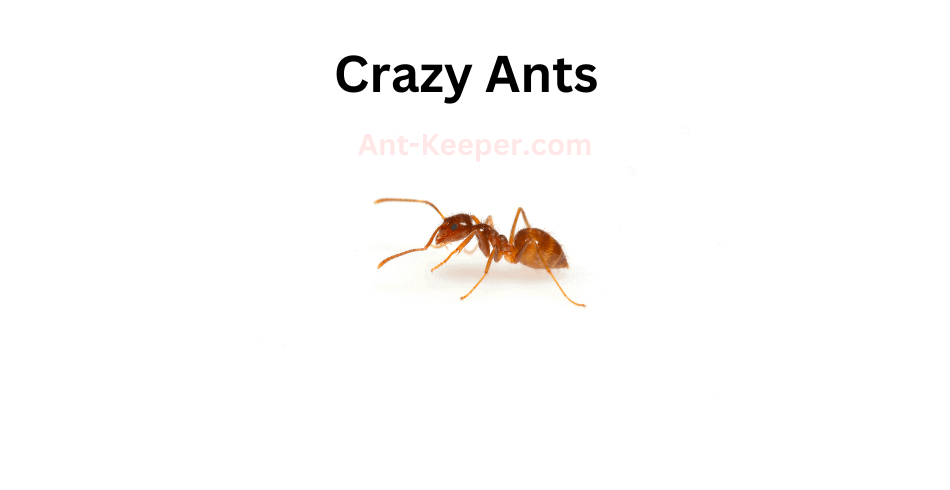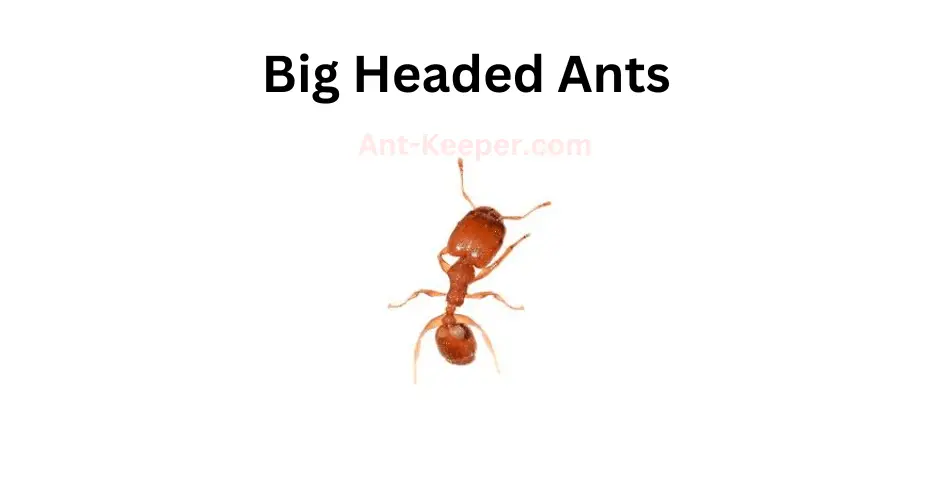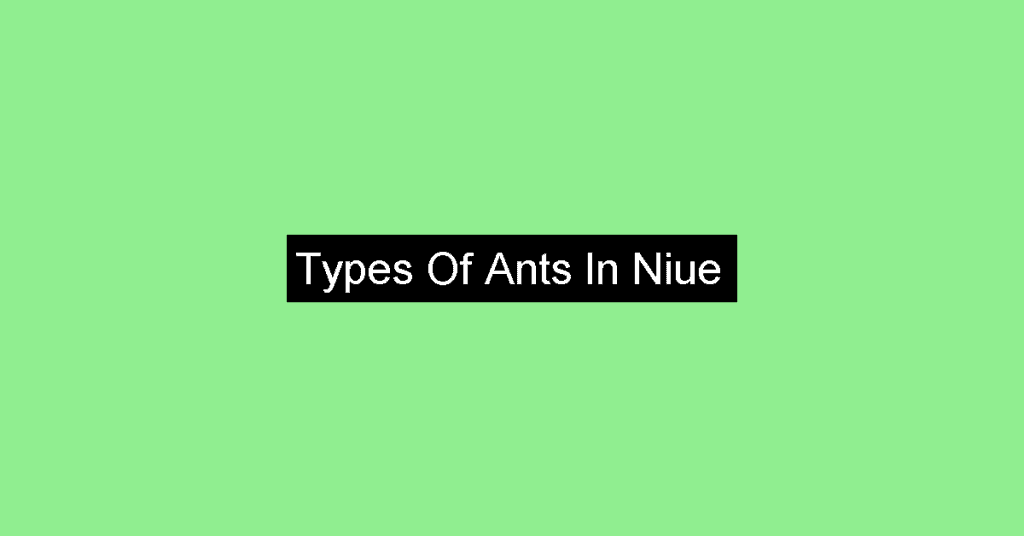Niue, a small island nation located in the South Pacific Ocean, is a true gem of the region. With a total land area of just 260 square kilometers, Niue is home to a diverse range of flora and fauna, including unique species of birds, reptiles, and marine life.
The island’s tropical climate, characterized by warm temperatures and high humidity, provides the perfect environment for these species to thrive. From lush rainforests to pristine beaches, Niue’s natural beauty is truly breathtaking.
In this article, we will explore the fascinating world of Niue’s environment, weather, and wildlife, providing a scientific perspective on this stunning island nation. .
Types Of Ants In Niue
The Types Of Ants In Niue are listed here: Trap-Jaw Ants, Carpenter And Sugar Ants, Acrobat Ants, Trailing Pharaoh And Timid Ants, Crazy Ants, Trap-Jaw Ants, Crazy Ants, Big Headed Ants, Syllophopsis.
If you’ve found some other ants in this region, contact us, and we will add them to the list!
1) Trap-Jaw Ants, Anochetus

Trap-jaw ants are a species of ants that belong to the genus Odontomachus.
These ants are known for their unique and powerful mandibles, which they use to capture prey and defend their colonies.
The mandibles of trap-jaw ants are capable of closing at incredible speeds, reaching up to 140 miles per hour.
This allows them to snap their jaws shut with incredible force, which can stun or kill their prey.
Trap-jaw ants are found in a variety of habitats, including forests, grasslands, and deserts.
They are typically active during the day and are known to be highly territorial.
These ants are also known for their ability to jump, which they use to escape danger or to capture prey.
Trap-jaw ants are omnivorous, meaning that they eat both plant and animal matter.
They are known to feed on a variety of insects, including other ants, as well as nectar and other sweet substances.
These ants are also known to be scavengers, feeding on dead insects and other organic matter.
The colonies of trap-jaw ants are typically small, with only a few hundred individuals.
However, they are highly organized and have a strict social hierarchy.
The queen is the largest member of the colony and is responsible for laying eggs.
The workers, which are all female, are responsible for foraging, caring for the young, and defending the colony.
Overall, trap-jaw ants are fascinating creatures that have evolved unique adaptations to help them survive in their environments.
Their powerful mandibles and jumping abilities make them formidable predators, while their social organization allows them to work together to protect their colonies and ensure their survival.
2) Carpenter And Sugar Ants, Camponotus

Carpenter ants and sugar ants are two common species of ants found in many regions of the world.
Carpenter ants are known for their ability to excavate wood and create nests within it.
They are typically larger in size than sugar ants and have a black or dark brown coloration.
Carpenter ants are also known for their strong mandibles, which they use to chew through wood and other materials.
Sugar ants, on the other hand, are smaller in size and have a yellow or brown coloration.
They are named for their preference for sugary foods and are often found in kitchens and other areas where food is stored.
Sugar ants are also known for their ability to form large colonies, with thousands of individual ants working together to gather food and care for their young.
Both carpenter ants and sugar ants play important roles in their ecosystems.
Carpenter ants help to break down dead wood and other plant material, which helps to recycle nutrients back into the soil.
Sugar ants help to disperse seeds and pollinate plants, which helps to maintain healthy ecosystems.
However, both species can also be pests when they invade human homes and buildings.
Carpenter ants can cause damage to wooden structures, while sugar ants can contaminate food and be a nuisance to homeowners.
It is important to take steps to prevent ant infestations and to control them if they do occur, in order to protect both human health and the health of the environment.
3) Acrobat Ants, Crematogaster

Acrobat ants, also known as Crematogaster spp., are a genus of ants that are found in various parts of the world.
These ants are known for their unique ability to contort their bodies and move in acrobatic ways, hence their name.
Acrobat ants are relatively small, with workers measuring between 2-5mm in length.
They are typically brown or black in color, with a slender body and long legs.
These ants are known for their aggressive behavior and will readily defend their nests against intruders.
One of the most interesting features of acrobat ants is their ability to use their mandibles to grip onto surfaces and contort their bodies in unusual ways.
This allows them to move along narrow branches, twigs, and other surfaces that would be difficult for other ants to navigate.
They are also able to use this ability to escape from predators, such as birds and other insects.
Acrobat ants are omnivorous, meaning that they will eat both plant and animal matter.
They are known to feed on insects, nectar, and honeydew, as well as fruits and seeds.
These ants are also known to tend to aphids, protecting them from predators in exchange for the sweet honeydew that the aphids produce.
In terms of their social structure, acrobat ants are typically organized into colonies that are led by a queen.
The queen is responsible for laying eggs, while the workers are responsible for foraging, caring for the young, and defending the nest.
Overall, acrobat ants are fascinating creatures that have adapted unique abilities to survive in their environments.
Their acrobatic abilities and aggressive behavior make them a formidable force in the insect world.
4) Trailing Pharaoh And Timid Ants, Monomorium

The Trailing Pharaoh ant, also known as the Monomorium pharaonis, is a small, reddish-brown ant species that is commonly found in urban areas.
These ants are known for their ability to form large colonies, which can consist of thousands of individuals.
One interesting behavior of the Trailing Pharaoh ant is their tendency to trail behind other ants.
This behavior is thought to be a form of communication, as the trailing ants are able to follow the scent trail left by the leading ants.
This behavior is also used to locate food sources, as the trailing ants are able to follow the trail to the source of the food.
In contrast to the bold behavior of the Trailing Pharaoh ant, the Timid ant, also known as the Temnothorax species, is a much more cautious species.
These ants are small and brown, and are often found in wooded areas.
They are known for their timid behavior, and will often retreat into their nests when threatened.
Despite their timid nature, the Timid ant is still able to form large colonies.
They are also known for their ability to adapt to changing environments, and can be found in a variety of habitats, including forests, meadows, and even urban areas.
Overall, both the Trailing Pharaoh ant and the Timid ant are fascinating species that demonstrate unique behaviors and adaptations.
By studying these ants, scientists can gain a better understanding of the complex social behaviors and ecological roles of ants in their respective environments.
5) Crazy Ants, Nylanderia

Crazy ants, also known as Nylanderia fulva, are a species of ant that belong to the family Formicidae.
They are small in size, measuring only about 2.2 to 3 mm in length, and are reddish-brown in color.
These ants are known for their erratic and unpredictable behavior, hence the name "crazy ants."
Crazy ants are native to South America, but have since spread to other parts of the world, including North America, Asia, and Australia.
They are highly adaptable and can thrive in a variety of environments, including urban areas, forests, and grasslands.
One of the most notable characteristics of crazy ants is their ability to form large colonies with multiple queens.
This allows them to quickly establish themselves in new areas and outcompete other ant species.
Crazy ants are also known for their aggressive behavior towards other insects and animals, including humans.
In addition to their aggressive behavior, crazy ants are also known for their ability to cause damage to electrical equipment.
They are attracted to electrical currents and can easily short-circuit electronics, causing damage and potentially starting fires.
Despite their small size, crazy ants are a formidable species that can have a significant impact on their environment.
As they continue to spread to new areas, it is important to monitor their behavior and take steps to control their populations in order to minimize their impact on ecosystems and human infrastructure.
6) Trap-Jaw Ants, Odontomachus

Trap-jaw ants are a species of ants that belong to the genus Odontomachus.
These ants are known for their unique and powerful mandibles, which they use to capture prey and defend their colonies.
The mandibles of trap-jaw ants are capable of closing at incredible speeds, reaching up to 140 miles per hour.
This allows them to snap their jaws shut with incredible force, which can stun or kill their prey.
Trap-jaw ants are found in a variety of habitats, including forests, grasslands, and deserts.
They are typically active during the day and are known to be highly territorial.
These ants are also known for their ability to jump, which they use to escape danger or to capture prey.
Trap-jaw ants are omnivorous, meaning that they eat both plant and animal matter.
They are known to feed on a variety of insects, including other ants, as well as nectar and other sweet substances.
These ants are also known to be scavengers, feeding on dead insects and other organic matter.
The colonies of trap-jaw ants are typically small, with only a few hundred individuals.
However, they are highly organized and have a strict social hierarchy.
The queen is the largest member of the colony and is responsible for laying eggs.
The workers, which are all female, are responsible for foraging, caring for the young, and defending the colony.
Overall, trap-jaw ants are fascinating creatures that have evolved unique adaptations to help them survive in their environments.
Their powerful mandibles and jumping abilities make them formidable predators, while their social organization allows them to work together to protect their colonies and ensure their survival.
7) Crazy Ants, Paratrechina

Crazy ants, also known as Nylanderia fulva, are a species of ant that belong to the family Formicidae.
They are small in size, measuring only about 2.2 to 3 mm in length, and are reddish-brown in color.
These ants are known for their erratic and unpredictable behavior, hence the name "crazy ants."
Crazy ants are native to South America, but have since spread to other parts of the world, including North America, Asia, and Australia.
They are highly adaptable and can thrive in a variety of environments, including urban areas, forests, and grasslands.
One of the most notable characteristics of crazy ants is their ability to form large colonies with multiple queens.
This allows them to quickly establish themselves in new areas and outcompete other ant species.
Crazy ants are also known for their aggressive behavior towards other insects and animals, including humans.
In addition to their aggressive behavior, crazy ants are also known for their ability to cause damage to electrical equipment.
They are attracted to electrical currents and can easily short-circuit electronics, causing damage and potentially starting fires.
Despite their small size, crazy ants are a formidable species that can have a significant impact on their environment.
As they continue to spread to new areas, it is important to monitor their behavior and take steps to control their populations in order to minimize their impact on ecosystems and human infrastructure.
8) Big Headed Ants, Pheidole

Big Headed Ants, also known as Pheidole megacephala, are a species of ant that belong to the family Formicidae.
These ants are known for their distinctive large heads, which are used for defense and communication within their colonies.
Big Headed Ants are typically found in tropical and subtropical regions, where they build their nests in soil, leaf litter, and other organic matter.
They are omnivorous, feeding on a variety of insects, seeds, and other small organisms.
One of the most interesting aspects of Big Headed Ants is their social behavior.
They live in large colonies, with a queen ant at the center of the hierarchy.
The queen is responsible for laying eggs, while the other ants in the colony perform various tasks such as foraging for food, caring for the young, and defending the colony from predators.
Big Headed Ants are also known for their ability to displace other ant species in their habitats.
They are aggressive and have been known to attack and kill other ants, as well as compete with them for resources.
Despite their aggressive behavior, Big Headed Ants are not considered a major pest species.
However, their ability to displace other ant species and their potential impact on native ecosystems make them an important species to study and monitor.
9) Syllophopsis
Syllophopsisbe is a species of ant that belongs to the family Formicidae.
These ants are known for their small size, measuring only about 2-3 millimeters in length.
They have a dark brown or black coloration and a slender body shape.
Syllophopsisbe ants are typically found in forested areas, where they build their nests in soil or leaf litter.
They are known to be arboreal, meaning they are capable of climbing trees and foraging for food in the canopy.
These ants are omnivorous, feeding on a variety of food sources including insects, nectar, and plant sap.
They are also known to engage in trophallaxis, a behavior where they exchange food and other substances with other members of their colony.
Syllophopsisbe ants are social insects, living in colonies that can range in size from a few dozen to several hundred individuals.
They have a hierarchical social structure, with a queen ant at the top and various worker ants performing different tasks such as foraging, nest building, and caring for the young.
Overall, Syllophopsisbe ants play an important role in forest ecosystems, contributing to nutrient cycling and serving as a food source for other animals.
Check Out Some Of Our Other Ants By Location Posts
| Types Of Ants In Turkmenistan | Nestled in the heart of Central Asia lies Turkmenistan, a country known for its diverse landscapes and unique climate. With its vast deserts, rugged mountains, ... |
| Types Of Ants In Campeche, Mexico | Campeche, a state located in the southeastern region of Mexico, is a land of diverse ecosystems and natural wonders. The region boasts a tropical climate ... |
| Types Of Ants In Sweden | Sweden, located in Northern Europe, is a country known for its stunning natural beauty and diverse wildlife. The country is bordered by Norway to the ... |
| Types Of Ants In United Kingdom | The United Kingdom, located in northwestern Europe, is a region known for its diverse and unique environment. The country is home to a variety of ... |
| Types Of Ants In Mauritius | Mauritius, a small island nation located in the Indian Ocean, is a true paradise for nature lovers. With its tropical climate, pristine beaches, and lush ... |
